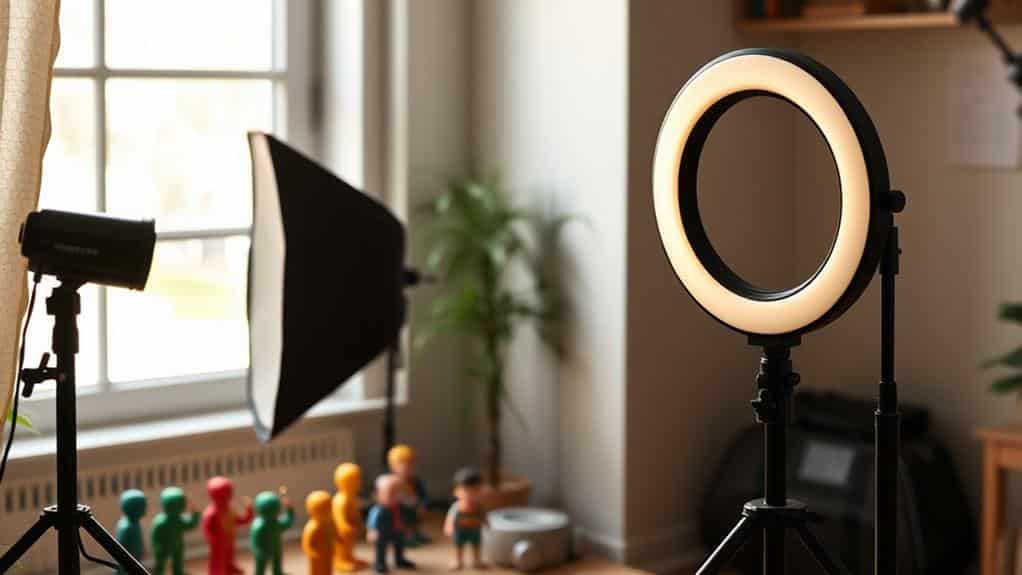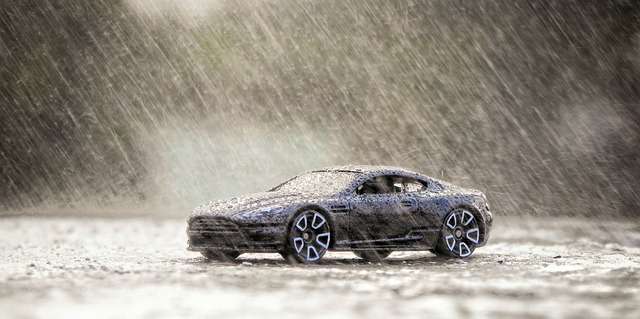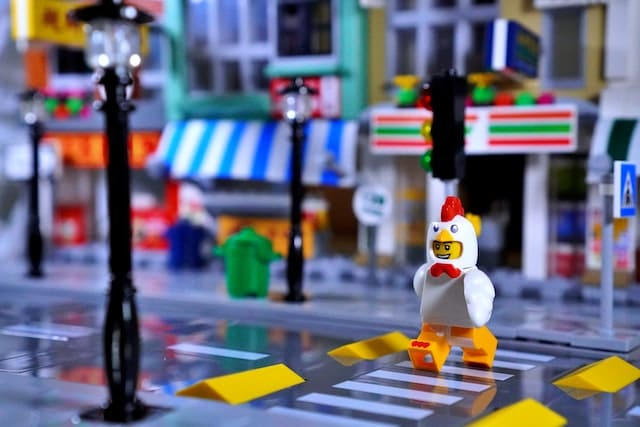When deciding between a softbox and a ring light for toy photography, consider your needs for lighting effects. A softbox offers diffused, even lighting, which is perfect for highlighting natural textures and true colors while minimizing harsh shadows. It's ideal for larger scenes in controlled settings. On the other hand, a ring light delivers bright, shadowless illumination, emphasizing vibrancy and details, great for close-ups and portability. Ring lights are handy for compact, quick setups but may create reflections on glossy surfaces. Each option has unique advantages, and understanding these can lead to more creative and expressive toy photography.
Understanding Softbox Lighting
Softbox lighting is a versatile and essential tool for enhancing the visual appeal of toy photography. When you're capturing the intricate details of your favorite action figures or dolls, softbox lighting can make a substantial difference. It diffuses light evenly across the subject, minimizing harsh shadows and reducing the risk of glare. This even distribution brings out the textures in your toys, highlighting every detail without overpowering the shot.
You'll find that a softbox is particularly useful in creating a natural look. It mimics the soft light of an overcast day, providing a flattering touch to your photos. When setting up, position the softbox at an angle that best suits your composition. Experimentation is key, as different angles can dramatically alter the mood and depth of your images.
Additionally, softboxes come in various shapes and sizes, allowing you to tailor your setup to the specific needs of your shoot. Whether you're working with a small tabletop softbox or a larger model, you'll have the flexibility to adjust the intensity and direction of light. This adaptability guarantees you can achieve the perfect lighting for any toy photography scenario.
Exploring Ring Light Features
When it comes to toy photography, a ring light can offer unique advantages that might surprise you. First off, its circular design creates even, shadowless illumination, perfect for capturing the intricate details of toys. You'll notice how this feature really makes colors pop, enhancing the toy's texture and vibrancy.
A ring light is incredibly user-friendly. It's typically lightweight and portable, allowing you to easily position it around your subject. Whether you're shooting in a small space or on the go, setting up is a breeze. Plus, many ring lights come with adjustable brightness and color temperature settings, giving you control over the mood and tone of your photos.
Another key advantage is the distinctive catchlight it produces. That circular reflection adds a professional touch to your photos, making even small toys look like they belong in a high-end catalog. Not to mention, ring lights are generally more affordable than other lighting setups, making them an appealing option if you're just starting out or on a budget.
Comparing Light Quality

As you consider lighting options for toy photography, understanding the differences in light quality between a ring light and a softbox is key. A ring light typically emits a direct, concentrated light. This can create bright highlights and vivid colors, making toy details pop. However, it tends to produce a harsher light, which can lead to unwanted reflections or shiny spots on glossy toy surfaces. If you're photographing toys with intricate details or want to highlight specific features, a ring light's direct illumination might be beneficial.
On the other hand, a softbox provides a diffused, softer light. This setup mimics natural light, spreading evenly across the subject and reducing harsh shadows. Softbox lighting is great for achieving a more natural, even look, which can be especially useful if your toys have matte finishes or if you want to create a gentle, dreamy atmosphere in your photos. This can add a professional touch without overwhelming the scene with intense brightness.
Ultimately, the choice between a ring light and a softbox depends on the kind of mood and detail you want to capture in your toy photography. Consider your subject and the desired effect to make the best decision.
Shadow Control Techniques
Mastering shadow control is essential in toy photography to enhance the subject's appearance and minimize distractions. Shadows can either add depth or become a nuisance, and you want to make sure they're working in your favor. Here are three techniques to help you control shadows effectively:
- Adjust Light Position: By moving your softbox or ring light closer or further, you can soften or sharpen shadows. A closer light source creates softer, more diffused shadows, while moving it further away results in harsher shadows.
- Use Reflectors: Placing a reflector opposite the light source can bounce light back onto the toy, filling in unwanted shadows. You can use anything from a professional reflector to a simple white card or poster board for this purpose.
- Experiment with Angles: Changing the angle of your light source can dramatically alter how shadows fall. Try different positions to see what works best for your subject. Sometimes, a slight tilt can make all the difference in achieving a more balanced and visually appealing image.
Portability Considerations

After mastering shadow control techniques, it's time to think about how the lighting equipment fits into your lifestyle, especially if you're on the move. If portability is a priority for you, consider the advantages and disadvantages of softboxes and ring lights. Softboxes tend to be bulkier and can take up more space in your luggage. Their setup and breakdown might require extra time, which can be inconvenient if you're shooting toys in various locations.
On the other hand, ring lights are typically more compact and easier to transport. Many models are designed to be lightweight, making them ideal for photographers who need to travel frequently. Ring lights usually come with adjustable stands and can be quickly assembled, saving you time and effort. This makes them a practical choice if you're capturing toy images in different settings.
However, consider the type of photography you're doing. If a softbox's quality of light is vital for your toy photos, it might be worth finding a way to accommodate its size. Ultimately, weigh the importance of portability against the desired lighting effect to guarantee you're making the best choice for your needs.
Budget-Friendly Options
When you're working with a tight budget, finding lighting solutions that don't break the bank becomes essential. Fortunately, both softboxes and ring lights offer affordable options that can enhance your toy photography without emptying your wallet. Here are some wallet-friendly choices to evaluate:
- Compact Softboxes: These smaller softboxes are perfect for toy photography. They're cost-effective and provide a nice, even light. Look for ones with adjustable stands, so you can easily position them to get the best angles on your toys.
- USB-Powered Ring Lights: If you're looking for something versatile and easy to use, USB-powered ring lights are a great choice. They're generally cheaper than larger setups and can be powered by your laptop or a portable charger, making them convenient for both indoor and outdoor shoots.
- DIY Solutions: If you're really pinching pennies, you can create your own softbox or ring light. A piece of white fabric over a lamp can mimic softbox lighting, while LED strip lights arranged in a circle can substitute for a ring light.
Best Choice for Toy Colors

Capturing the vivid colors of toys can be quite a challenge, but choosing the right lighting can make all the difference. When it comes to showcasing those bright reds, blues, and yellows, a softbox might be your best friend. Softboxes provide even, diffused lighting that reduces harsh shadows and highlights, allowing the true colors of the toys to shine. They eliminate glare, which is especially useful if you're dealing with glossy surfaces or intricate details.
On the other hand, a ring light offers a distinct advantage for certain color presentations. It creates a uniform light source with a unique circular catchlight. If you're shooting up close or focusing on specific details, a ring light can enhance those elements while maintaining vibrant colors. However, it may not provide the same level of evenness across larger scenes.
Consider what you're aiming for in your photos. If you want to capture a toy's entire spectrum of color without distortion, a softbox is likely your best bet. But if you're targeting close-ups or need a portable option, a ring light can still highlight those brilliant hues effectively. Ultimately, your choice depends on the specific needs of your toy photography.
Frequently Asked Questions
How Do Lighting Techniques Differ for Photographing Small Versus Large Toys?
When photographing small toys, focus on softer, diffused lighting to avoid harsh shadows. For larger toys, use more directional light to highlight details. Always position lights to enhance features and create depth in your images. When shooting scenes with toys, incorporating elements like miniature food props for toys can add a whimsical and realistic touch to your photos, creating a narrative that draws viewers in. Experiment with different angles to emphasize scale and bring out the personality of the toys in the shot. Additionally, consider using a backdrop that complements the colors and theme of your setup, ensuring the focus stays on the toys and their miniature world.
Can Softbox or Ring Light Affect the Texture Appearance of Toys in Photos?
Using a softbox or ring light can subtly enhance or downplay the texture of toys in photos. A softbox casts gentle illumination, smoothing out details, while a ring light highlights textures, making them pop. Choose based on desired effect.
Are There Safety Considerations When Using Lights Around Children's Toys?
When using lights around children's toys, guarantee they're securely positioned to avoid tipping. Keep cords out of reach to prevent tripping hazards. Always monitor the temperature to guarantee lights don't overheat and pose a burn risk.
Do Different Light Settings Impact the Mood or Theme of Toy Photography?
Studies show 80% of viewers respond emotionally to lighting changes. You can dramatically alter toy photography's mood by adjusting light settings. Experiment with warm tones for a cozy feel or cool tones for a futuristic vibe.
What Are the Best Practices for Maintaining Lighting Equipment When Photographing Toys?
To maintain lighting equipment, regularly clean your lights with a microfiber cloth. Store them in a dry place, away from dust. Check cords for damage. Calibrate settings before shoots to guarantee consistent lighting for your toy photography.
At a Glance
When you're capturing toy magic, both softboxes and ring lights have their charms. Softboxes create gentle, flattering light that makes colors pop, while ring lights offer a playful, even glow that's easy to love. Shadow control is a breeze with softboxes, but portability's a win for ring lights. Budget-wise, both have friendly options. Ultimately, the "best" choice depends on your creative whims—follow your heart and let your toys shine in their best light!





